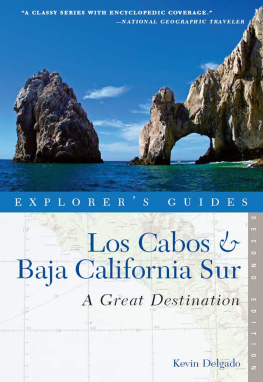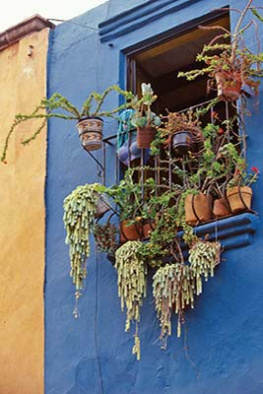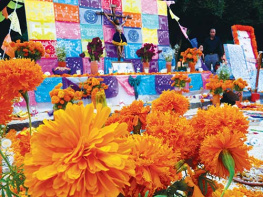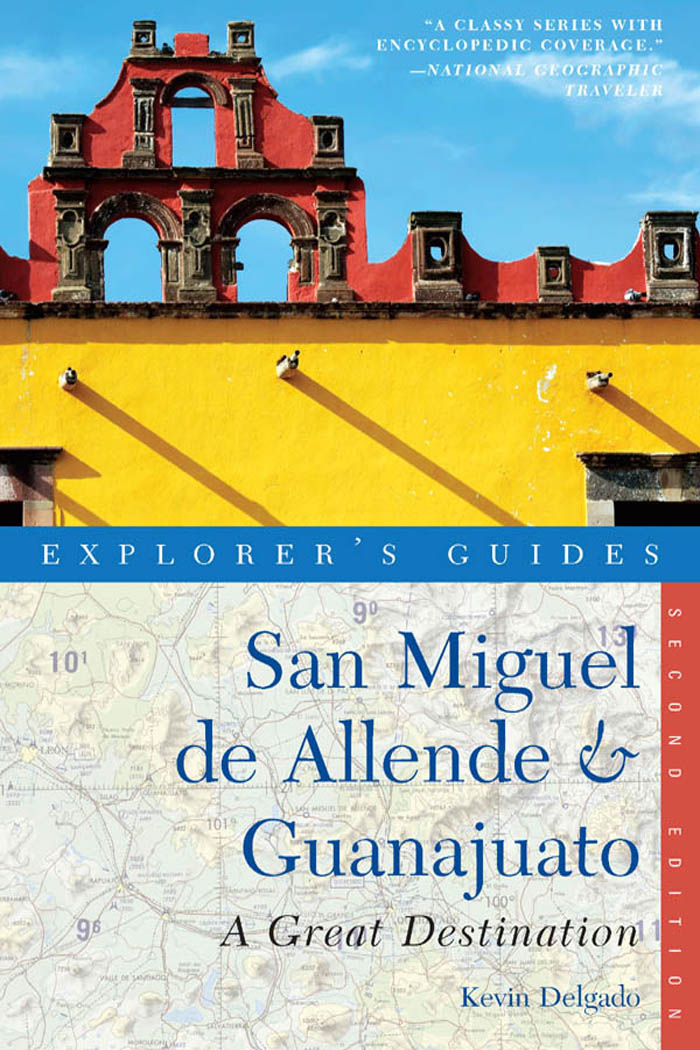E X P L O R E R S G U I D E S
San Miguel de Allende & Guanajuato

E X P L O R E R S G U I D E S
San Miguel de Allende & Guanajuato
A Great Destination
Kevin
Delgado
SECOND EDDITION
 The Countryman Press
The Countryman Press  Woodstock, Vermont
Woodstock, Vermont
Copyright 2011 by Kevin Delgado
All rights reserved. No part of this book may be reproduced in any form or by any electronic or mechanical means including information storage and retrieval systems without permission in writing from the publisher, except by a reviewer, who may quote brief passages.
Explorers Guide San Miguel de Allende & Guanajuato: A Great Destination
ISBN: 978-1-58157-131-8
Fronticepiece photo, Coast to Coast Photography/iStockphoto.com
Interior photographs by the author unless otherwise specified.
Maps by Erin Greb Cartography, The Countryman Press
Book design by Joanna Bodenweber
Composition by Eugenie S. Delaney
Published by The Countryman Press, P.O. Box 748, Woodstock, VT 05091
Distributed by W. W. Norton & Company, Inc., 500 Fifth Avenue, New York, NY 10110
Printed in the United States of America
10 9 8 7 6 5 4 3 2 1
For my dad.

Contents
MAPS
Acknowledgments
THERE IS A BLACK AND WHITE PICTURE on my sisters living room wall of a dark, mustachioed man in the round straw hat of a farmworker. He is not smiling, nor does he look as though he has much of a sense of humor. However, I cannot help but smile every time I look at the picure. He is my grandfather, and that picture is one of the very few of him that exist. He was a shoemaker from Guanajuato who, against all common sense, uprooted his family from the only land they ever knew and trudged them north in search of a better life. It was an arduous journey, and at times extremely tragic, but after many years he found a new home in a cinder block shack along a dirt road in southeastern Wyoming. My older brothers and sisters would tell stories about him in his later years; how he would walk along that dirt road where, by that time, many of his children had also settled, and his grandchildren would run out to meet him. He didnt speak much English and his grandkids didnt speak much Spanish, but they were always happy to see him and he always seemed to have chewing gum ready to hand out. Unfortunately, I never met my grandfatherbut I always felt a certain connection to that picture. Perhaps it is his strong resemblance to my father, or the stories told to me by my aunts. But when I was older I traveled to Guanajuato with a sense of anticipation, and found I could not walk along its streets without thinking of my grandpa. I still walk along the streets looking for that stern face in the people I pass, and it makes me smile. This book is for my grandparents and their childrenAunt Lupe, Aunt Dolores, Uncle John, Aunt Sadie, Uncle Joe, Aunt Francis, Aunt Isabel, Aunt Rose, Uncle Tony, and, of course, my dad.
I am forever in the debt of the cast of characters whose stories and insights have contributed to this book. Thanks especially to Mike Brady for all the rides to and from the border and for all the travel and photography advice. Thanks to John Harten, Greg Zsulgit, and the other Yampounding Sherpas, for your wisdom and for dragging me along on all those adventures. I am thankful for the kindness, support, and assistance of the hoteliers, restaurant owners, tour operators, and others whom I visited during my research. Thank you to Betty, Monica, and Robert, as well as to Penny and Todd for keeping an eye on the kidsand to Daniel, Summer, Riley, and Isabel for your patience; to my parents, for always giving me a chance; to my brothers and sisters (Mickey, D. J., Lori, Barbie, Davie, Teddy, Brian, Penny, Darren, Ryan, and Sean), for making me who I am; to my old buddy, Brian Schwartzkopf; to Mona Klausing, just for being there; and, notably, thank you Simon Lozano and Craig Sodaro for teaching me to write. And, of course, thank you Mary, for all you do for me.

Guanajuato is honeycombed with narrow alleys. Mara Miller Kisska
Introduction
WHEN MOST PEOPLE THINK about a Mexican vacation, an image immediately comes to mind. Youre sitting under an umbrella on a white sand beach and looking out over a crystal blue sea, while sipping on a margarita that was just served to you by the same guy that carried your luggage to your room yesterday and served you breakfast today. That Mexico exists in many places along the Pacific Coast, the Yucatn Peninsula, and very near the spot where you may have taken this book off the shelf at your local bookstore. This book isnt about that Mexico. This is about the state of Guanajuato, which is completely landlocked by a bunch of other landlocked states (well, Michoacn isnt completely landlocked, but you get the point). Moreover, it is not a place where you will find very many brand-name hotels, and there are none at the center of the action. You will also not find any all-inclusive resorts with 24-hour buffets, or familiar fast food restaurants. In short, this book is about a place that is likely outside your normal comfort zone. No need to fret, however. In San Miguel de Allende, Guanajuato, and Dolores Hidalgo, you will find towns that are extremely safe and full of people who will welcome you as their guest and proudly show you the wonders of their cities. And there are wonders.
Even if you live along the East Coast of the United States or Canada, you probably see very few buildings that are more than a couple hundred years oldand those that are old are likely surrounded by structures that were put up much more recently. However, a walk along the cobblestone streets of these Central Mexican towns is a rare journey in North America, because you are surrounded by entire blocks that exist much as they did in the 17th and 18th centuries. And while the residents of these towns have done much over the last century to preserve their historic treasures, it was a tumultuous and complicated course of events that allowed the buildings to survive into the 21st century.

A brass band entertains in Jardn de la Unin.
Early on in the history of Spanish colonization, San Miguel de Allende became a fashionable place to live for the wealthy families of Central Mexico. The investment that these families put into their town can be seen all over the central district of that city today. As for Guanajuato, the vast wealth from massive veins of silver discovered in the surrounding hills fueled the investment in infrastructure that made this city one of the jewels of colonial Mexico. However, the good times didnt last. Political instability, war, and economic hardship in effect froze these cities in time. For a while many of Guanajuatos great architectural works fell into disrepair, with one of its churches sitting in rubble for decadeswhile San Miguel de Allende was all but abandoned. On the other hand, Dolores Hidalgo came to be known as








 The Countryman Press
The Countryman Press  Woodstock, Vermont
Woodstock, Vermont

